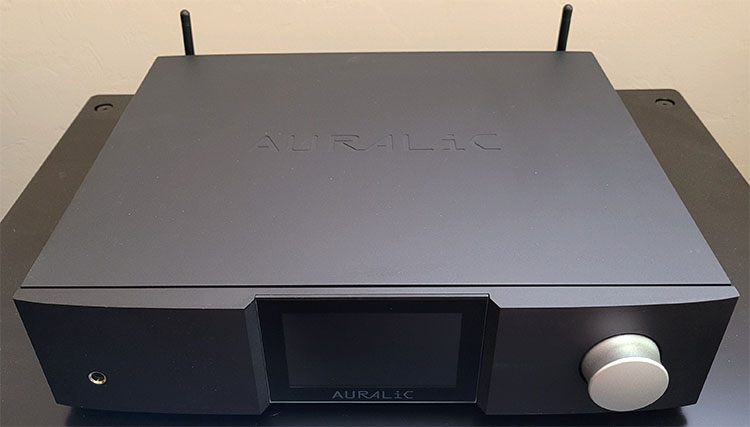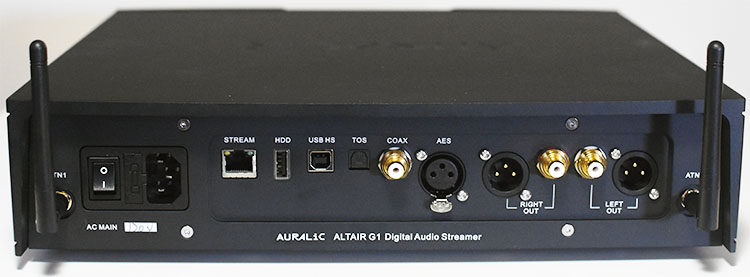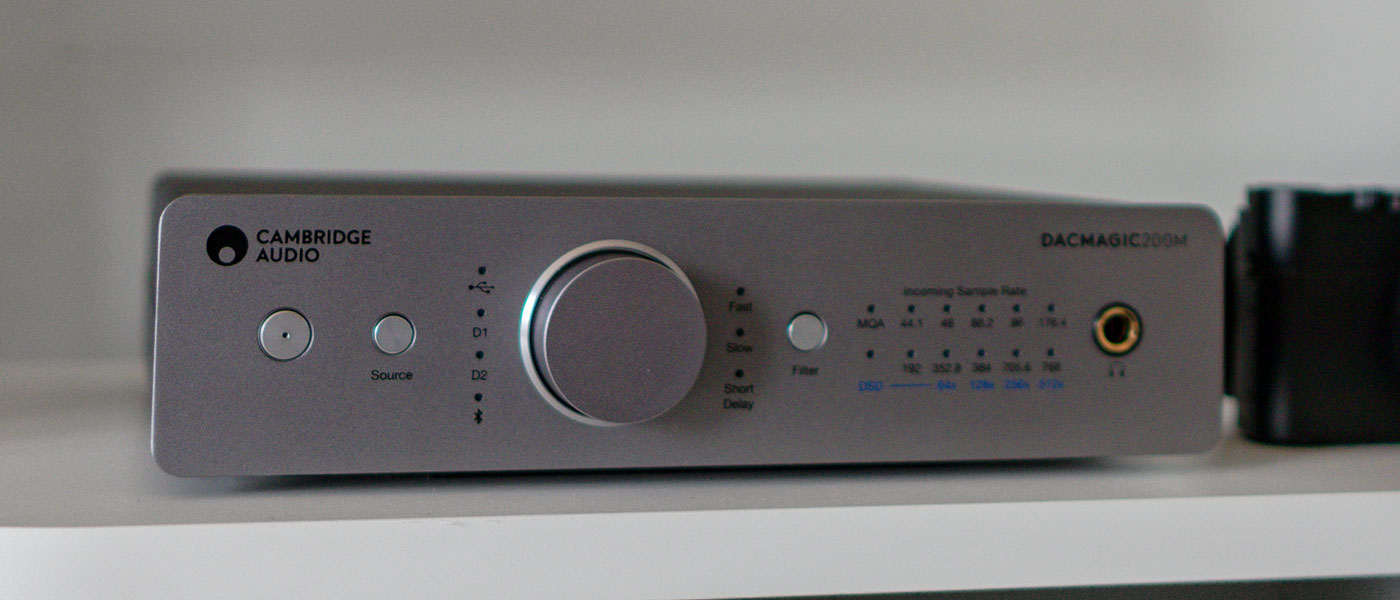
About 4 years ago, I reviewed the original AURALiC ALTAIR, which was an audio streamer/DAC combination unit that could also function as a digital preamplifier. The ALTAIR managed to impress me with its ability to do all its functions well. The updated ALTAIR, called the ALTAIR G1, sports a new look that bears similarity with the other AURALiC’s G1/G2 series of products. The ALTAIR G1 still maintains the functionalities of the original ALTAIR with improvements in CPU processing speed, memory cache size, and networking technology. With the improvements, the ALTAIR G1 also carries a higher price tag of $2889 (the original ALTAIR was $1899). How do these changes affect the performance of the ALTAIR G1?

AURALiC ALTAIR G1 Wireless Streamer/DAC
- Excellent build quality.
- Understated handsome look with 4-inch high-resolution true-color front-panel display.
- Network streaming capability up to DSD512 and 32 bit/384 kHz PCM.
- Bluetooth streaming feature.
- Versatile DAC functions with AES, coaxial, optical, and high-speed USB digital inputs.
- Smart IR remote control feature.
- Wireless playback control using Lightning DS control app.
- Volume control feature for digital preamplifier functionality.
The ALTAIR G1 reviewed here is the updated version of the AURALiC’s ALTAIR product line, a combination of wireless streamer and full-featured DAC that can also function as a digital preamplifier, which I reviewed very favorably almost four years ago. What’s not to like about a component that was able to decode most digital music files, be they PCM or DSD, including the high-resolution ones, and had overall strong sonic performances to go with its versatility? My fondness for the ALTAIR prompted me to purchase the review sample, which has been a steady occupant of my second system in the bedroom. Occasionally, it makes its way to my main system, usually if there is a review need. The reason I do not put it regularly in the main system is to reduce duplication of component functions, as I have already its sister product, the ARIES G1, which is a wireless streamer, and a separate DAC there.
Secrets Sponsor
The ALTAIR G1 maintains most of the features of the original ALTAIR with some hardware design changes. The new-look chassis, the computing platform upgrade, the use of the newer DAC chip, and the networking technology update constitute the main changes implemented in the ALTAIR G1, which has an MSRP of $2889. In my review below, comparisons between the ALTAIR G1 and the original ALTAIR will be made from time to time, so readers can relate better with what the ALTAIR G1 brings to the table.
Streaming File Formats
Lossless:
AIFF, ALAC, APE, DIFF, DSF, FLAC, OGG, WAV, and WV
Lossy:
AAC, MP3, MQA, and WMA
Sampling Rates
PCM:
44.1 kHz to 384 kHz in 32Bit
DSD:
DSD64(2.8224 MHz), DSD128(5.6448 MHz), DSD256(11.2896 MHz), DSD512(22.57892 MHz)
Control Software
AURALiC Lightning DS for iOS
AURALiC Lightning DS for web browser (device settings only)
OpenHome compatible control software (BubbleUPnP, Kazoo)
Roon (Roon Core required separately)
Audio Inputs
Digital Inputs:
AES/EBU, Coaxial, Toslink, USB Audio
Streaming Inputs:
Network shared folder, USB Drive, optional internal storage, UPnP/DLNA Media Server, native TIDAL and Qobuz Sublime+ streaming, Internet Radio, AirPlay, Bluetooth, Songcast, RoonReady
Audio Outputs
Balanced:
XLR (4.5Vrms at 0dBFS, output impedance 10 ohms)
Unbalanced:
RCA (4.5Vrms at 0dBFS, output impedance 50 ohms)
Headphone:
6.35mm Headphone Jack (output impedance 5 ohms)
Frequency Response:
20 – 20 kHz, +/- 0.1dB*
THD+N:
< 0.0002% (XLR); < 0.0003% (RCA), 20 Hz-20 kHz at 0dBFS
Dynamic Range:
124dB, 20 Hz-20 kHz, A-weighted
Network
Wired:
Gigabit Ethernet
Wireless:
802.11b/g/n/ac Tri-Band WiFi
Power Consumption
Playback:
50W max
Dimensions – W x D x H: 13.4 x 12.6 x 3.2 in. (34 cm x 32 cm x 8 cm)
Weight: 15 lbs (6.8 kg)
MSRP: $2889
Website:
Company Directory:
SECRETS Tags:
auralic, altair, dac, streamer, high resolution, DAC review, review 2021
Departing from the appearance of the original ALTAIR, the ALTAIR G1 carries the simple yet handsome signature look of the AURALiC’s G1/G2 product line, which sports an anodized aluminum case in a black matte finish with a 4-inch color LCD display occupying the middle part of the front panel. The silver rotary knob on the front panel gives it a two-tone accent, which I think enhances its overall handsome look. This rotary knob serves as a standby/off push button and also as a rotary selector when navigating through its menu system. The only other item sported on the ALTAIR G1’s front panel is the headphone jack. Typical to products from AURALiC, the build quality of the ALTAIR G1 is nothing short of excellent.
The 4-inch display on the front panel has over 300 dpi resolution and displays information on the operational status of the unit: playback status, configuration setting, and music library browsing. In streaming mode, it also displays the album-cover picture of the track played in full color, if the source provides. I have lived with such a display (in the ARIES G1) for a while now and I find it appealing and informative. It displays sufficient information in good-size digits, so the data displayed can be read comfortably from my listening position of about 8-9 ft away from the unit. This display can be dimmed or completely turned off if desired. A Less-than-halfway dim-level setting was usually sufficient for me. This display is not of a touch-screen variety, so the navigation and selection of the menu for operating the device must be done from a remote control (that has been programmed to work with the unit) or using the rotary knob on the front panel.

The input connectors on the rear panel of the ALTAIR G1 are nicely laid out and consist of receptacles for two Wi-Fi antennas, an Ethernet port, an external hard disk USB connector, and a set of digital input connectors (AES, coaxial, optical, and USB). The outputs consist of a pair of balanced (XLR) and unbalanced (single-ended) connectors. Unlike the original ALTAIR, the ALTAIR G1 no longer provides a USB output, which rules out the use of an external DAC with it. The review sample does not come with an internal hard drive, but should you desire, you can opt for a unit that has been integrated with a 2TB internal SSD for an additional $400.

The ALTAIR G1 utilizes the Tesla G2 platform as its main processing unit, which is more powerful than the Tesla G1 platform used in the original ALTAIR. The Tesla G2 platform has up to 37,500 MIPS processing speed and 1 GB of RAM, sufficient for handling a vast variety of audio formats with sampling rates up to 32 bit/384 kHz for PCM signals or DSD512 for DSD signals. The platform also serves as the unit’s software processing engine as well as advanced DSP functionality. This higher processing capability is also needed to account for the processing power needed by the LCD display. Other aspects that represent upgrades from the original ALTAIR are the use of newer networking technology and a newer ESS Sabre DAC chip (9038Q2M).
Most other features in the ALTAIR G1 are derived from the original ALTAIR, which includes the use of Purer-PowerTM linear power supply to reduce DC current noise by as much as 90 dB, dual Femto clocks to reduce jitter on the output signals (one is for the AES/EBU, coaxial, and Toslink outputs, while the other one is dedicated to the USB controller), and flexible filter modes to adjust the audio output nuances based on one’s preference.
The ALTAIR G1 is not supplied with a remote control. However, it has the Smart-IR Remote Control feature to let you map the device’s remote commands onto any remote of your choice. The ARIES G1 that I own also has this Smart-IR feature, but I do not feel the need to use it since it is a single function device (wireless streamer) that I can easily control using an app on a mobile device. But in the case of ALTAIR G1, which is a multifunction device, I do feel the need to have a remote control programmed with its Smart-IR to switch inputs or to adjust the volume if it is used in the variable-volume mode.

AURALiC supplies its own iOS app, called Lightning DS, which can be primarily used for streaming control and, to some degree, for configuring and changing the settings of the ALTAIR G1 (and other AURALiC products). If you don’t have an iOS device, you can also modify the ALTAIR G1 settings using Lightning Web Control Interface, which can be accessed using a web browser on any platform, once the network connection has been established. The Lightning DS app has a good user interface especially for streaming control and it is continually updated by AURALiC. If you prefer, you can also control streaming playback on the ALTAIR G1 using Roon or other UPnP control apps such as BubbleUPnP. BubbleUPnP is my go-to app for controlling the ALTAIR G1 using an Android device.
The ALTAIR G1 has a similar menu system to the other AURALiC’s G1/G2 series of products, which I own or have reviewed in the past, so I am quite familiar with it. If you are new to AURALiC’s product, fret not, as the ALTAIR G1 comes with a manual that can clearly guide you through the various features and setup steps of the product. Except for the streamer function, the other functions of the unit are pretty much plug and play. To use it as a DAC for example, just connect the output of the digital sources to the appropriate digital inputs of the ALTAIR G1, turn on the unit by pressing the rotary knob, and then select the input for playback from the menu or remote control. To use it as a streamer, an initial setup connecting the device to the network needs to be done. This can be accomplished using the front-panel display system (by navigating the menu using the front-panel buttons) or using the Lightning DS app. I tried both the Ethernet and Wi-Fi network connections with good success. Both gave me comparably stable and quick responses to streaming commands (my Wi-Fi was rated at 400 Mbps download speed), and thus for convenience, Wi-Fi connection is what I used most of the time during the review.
Using the variable-volume setting, the ALTAIR G1 can be used as a stand-alone digital preamplifier. I found the volume control feature of the ALTAIR G1 did not noticeably degrade the sound quality and thus, I would not hesitate to use it this way. However, since I needed the analog switching capability, most of the time during the review, I set the ALTAIR G1’s volume as fixed and connected it to the Classé CP-500 preamplifier. Playback volume control was done using the CP-500 preamplifier, which was connected to the Bel Canto Ref500S stereo amplifier driving the Revel Ultima Studio speakers. AURALiC’s own ARIES G1 was also used as a digital source to the ALTAIR G1 to evaluate its DAC functionality.
Used as a conventional DAC, the ALTAIR G1 is an excellent performer. Its capability to decode PCM and DSD signals was state of the art. Although its digital AES, coaxial, and optical inputs are limited to processing PCM signals up to 24 bit/192 kHz (typical limitation of these types of connection), its USB input (and also streaming) is capable of processing both PCM signals up to 32 bit/384 kHz and DSD signals up to DSD512. Even though is not MQA-licensed, the ALTAIR G1 can playback MQA signals using AURALiC’s proprietary method. I did try feeding the ALTAIR G1 with various types of signals (PCM, DSD, and MQA at various sampling rates) through the USB output of the ARIES G1, and went away impressed as the ALTAIR G1 recognized the type of the signal almost as soon as the signal reached it and played it back without any single glitch. The ALTAIR G1 is equipped with four selectable Filter Modes: precise, dynamic, balance, and smooth. These are the same filter modes found in the other AURALiC products and I have covered them in my reviews of the original ALTAIR, ARIES G1, and ARIES G2, and thus I will not repeat it here. I just reiterate here that these filters are digital processing filters, each of which has its own sonic attributes. Of the four filters provided, my favorite is the smooth filter, which to my ears produces the most analog sonic rendition out of the digital signal sources. Your taste and preference may vary.
Sonic-wise, the DAC in the ALTAIR G1 has a neutrally balanced sonic character with sufficient presentation of details. This DAC also has great capability in resolving image and soundstage in the recording. Subjectively, the ALTAIR G1’s DAC performance should compete well with DACs in the $2000ish price range. A brief comparison with the older PS Audio PerfectWave DAC II (MSRP was $4000) revealed that the ALTAIR G1 delivered respectable DAC performance that could hold its ground well. In my system, it did not beat the older PS Audio PerfectWave DAC II in sonic smoothness, image focus, and soundstage expansiveness, but it sure did give it a run for its money in the other aspects of performance.
As a streamer, the ALTAIR G1 is awesomely versatile. It did not seem to lose any grip in handling a vast variety of music file formats, be they lossy or lossless, using whatever streaming method chosen. Whether streaming using Bluetooth or network, the results were equally satisfying. Of course, due to Bluetooth limitations, only streaming lossy music file formats are possible using such a connection. To stream lossless and high-resolution music files, a broadband network connection is the way to go. Although the ALTAIR G1 produces sonically respectable outcomes in playing lossy file formats such as mp3 or AAC, its bread and butter is in streaming lossless audio formats, such as lossless FLAC or DSD. Aided with the Lightning DS app, the streaming operation of the ALTAIR G1 is fun to use and robust. Its snappiness in accessing streaming music files is impressive. In this regard, it is much improved over the original ALTAIR. Gone is the rather slow buffering time in the streaming operation that I sometimes experience with the ALTAIR, which I think is attributed to the use of the newer networking technology on the ALTAIR G1. I did not even notice any difference between the buffering delay in streaming high-resolution DSD512 files and the regular 16-bit/44.1-kHz music files with the ALTAIR G1. The available network speed might influence this, but with the 400 Mbps home network speed that I currently have, whatever music file I select to stream seems to playback almost instantaneously on the ALTAIR G1.

“La Vie en Rose“, Love, Michael Bublé, 2018
During the review, I used the ALTAIR G1 to stream music files from a network hard drive and streaming services such as Qobuz and Tidal. Compared to the original ALTAIR, I do think the ALTAIR G1 has an overall better sonic performance. Even though balance across the audible frequency spectrum is equally excellent through both units, music generally sounds more transparent and has a tad better clarity through the ALTAIR G1, which heightens the sense of musical presence.
The track La Vie en Rose by Michael Bublé, featuring Cécile McClorin Salvant from, his album Love (2018) is a great example of music that exemplified the ALTAIR G1’s ability to flesh out this musical presence. Listening to this track through the ALTAIR G1, I felt that the whole performance was palpably presented intimately in front of me. Both Michael Bublé’s and Cécile Salvant’s vocals sounded very natural and lifelike. Each vocalist and musician is portrayed in their own unmistakable space in the projected image. The whole soundstage of the presentation was realistic with believable depth and width.

“On a Clear Day – A Town with an Ocean View“, Symphonic Suite “Kiki’s Delivery Service”, Joe Hisaishi & New Japan Philharmonic World Dream Orchestra, 2020
The track On a Clear Day – A Town with an Ocean View from the live-recording album Symphonic Suite “Kiki’s Delivery Service” (2020) by Joe Hisaishi & New Japan Philharmonic World Dream Orchestra clearly displayed the ALTAIR G1’s adeptness in tonal balance across the audible frequency spectrum as well as in presenting details in the program material.
The ALTAIR G1 also conveyed the texture and dynamics in the music extremely well, hence the whole presentation felt lively. These aspects together with its smooth midrange, extended treble, and great bass definition, made the whole orchestral presentation grand, as it should be.
Since I have the ARIES G1, which is a specialized streamer with the same price tag of $2889 as the ALTAIR G1, I did make a comparison between the streaming sonic performance of the two. For this purpose, the ALTAIR G1 served as a DAC to the ARIES G1 using its USB connection. They are both equipped with the same computational platform and controllable using the same Lightning DS app, so it was a given that they exhibited a practically identical feel to me in streaming operation. Sonically, though, I have to give a nod to the ARIES G1/ALTAIR G1 combo. Not by much, but this comparison reveals that the ARIES G1/ALTAIR G1 combo produced slightly more-refined sonic characteristics with sharper image focus and better rendition of musical textures as compared to the standalone ALTAIR G1. Considering that the ARIES G1 is a specialized product, this result is hardly surprising. The fact that the ALTAIR G1 can hold its ground well in this regard, coupled with its multi-function nature solidifies my appreciation of its value.
Secrets Sponsor
Finally, I’d like to note that the headphone amplifier feature of the ALTAIR G1 is much improved over the one in the original ALTAIR. AURALiC seemed to add the headphone feature in the original ALTAIR as just a throwaway convenience and did not care about its performance much. But, the improved headphone sonic performance in the ALTAIR G1 makes me think that AURALiC considers it as one of the important features of the product now. Clarity and transparency were the sonic attributes that were noticeably improved when listening using Massdrop X Sennheiser HD6XX headphones through the ALTAIR G1. Midrange sounded solid, treble was extended but not excessive, and bass was plentiful and well defined. The sense-of-space presentation was no slouch either, although as noticeable on some tracks, this seemed to be the area that could use some improvement. But overall, the headphone feature of the ALTAIR G1 is respectable and should satisfy casual to moderately serious headphone listeners.
The ALTAIR g1 is a versatile product that is loaded with features and performs all its functions competently. Coupled with its refined sonic performance, the ALTAIR G1 offers substantial value at its price point.
- Simple handsome look with excellent build quality
- High-resolution front-panel display
- Snappy streaming playback operations
- Versatile Lightning DS control app
- State-of-the-art DAC decoding features
- Smart IR remote control feature
- Great sound quality
- None
Needless to say, AURALiC has successfully created a worthy successor to its ALTAIR product line in the ALTAIR G1. AURALiC manages to keep the versatile nature of the product while changing its appearance and improving some of its key elements. The ALTAIR G1 sports an understated handsome look, is well built and is equipped with an enhanced computational platform, newer DAC chip, and improved networking technology. These improvements result in noticeably quicker and robust streaming performance, and more importantly, audibly improved sonic performance. The ALTAIR G1 is a solid streamer/DAC/digital preamplifier combo product that performs all its functions extremely well while exhibiting refined sonic performance. While I still like the original ALTAIR, I like the ALTAIR G1 more. In my opinion, the ALTAIR G1 brings significant value that justifies its price of admission and for that, I recommend it highly.


